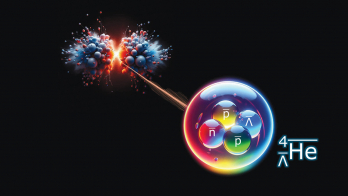
Image credit: M Brice/CERN.
The Baryon Antibaryon Symmetry Experiment (BASE) collaboration at CERN has made the most precise direct measurement of the magnetic moment of the antiproton, allowing a fundamental comparison between matter and antimatter.
The BASE measurement shows that the magnetic g-factors (which relate the magnetic moment of a particle to the nuclear magneton) of the proton and antiproton are identical within the experimental uncertainty of 0.8 parts per million: 2.7928465(23) for the antiproton, compared to 2.792847350(9) for the proton. The result improves the precision of the previous best measurement by the ATRAP collaboration in 2013, also at CERN, by a factor of six.
Comparisons of the magnetic moments of the proton and antiproton at this level of precision provide a powerful test of CPT invariance. Were even slight differences to be found, it would point to physics beyond the Standard Model. It could imply, for example, the existence of a new vector boson that couples only to antimatter, which could have a direct effect on the lifetime of baryons. Such effects more generally could also shed light on the mystery of the missing antimatter observed on cosmological scales.

BASE uses antiprotons from CERN’s Antiproton Decelerator (AD), which serves several other experiments making rapid progress in precision antimatter measurements (CERN Courier December 2016 p16). By trapping the particles in electromagnetic containers called Penning traps and cooling them to temperatures below 1 K, the BASE team can measure the cyclotron and Larmor frequencies of single trapped antiprotons. By measuring the ratio of these two frequencies the magnetic moment of the antiproton is obtained in units of the nuclear magneton.
Similar techniques have been successfully applied in the past to electrons and positrons. However, antiprotons present a much bigger challenge because their magnetic moments are considerably weaker, requiring BASE to design Penning traps with about 2000 times higher sensitivity with respect to magnetic moments. BASE now plans to measure the antiproton magnetic moment using a new double-Penning trap technique, which should enable a precision at the level of a few parts per billion in the future.







